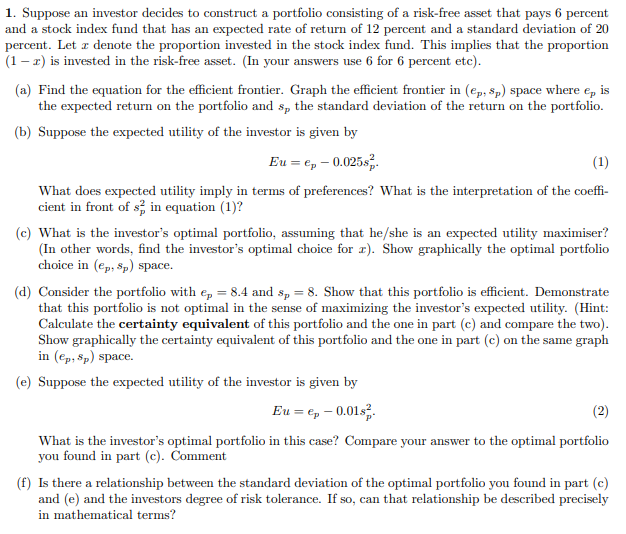
1. Suppose an investor decides to construct a portfolio consisting of a risk-free asset that pays 6 percent and a stock index fund that has an expected rate of return of 12 percent and a standard deviation of 20 percent. Let e denote the proportion invested in the stock index fund. This implies that the proportion (1-2) is invested in the risk-free asset. (In your answers use 6 for 6 percent etc). (a) Find the equation for the efficient frontier. Graph the efficient frontier in (ep, sp) space where ez is the expected return on the portfolio and sp the standard deviation of the return on the portfolio. (b) Suppose the expected utility of the investor is given by Eu = p -0.0255 (1) What does expected utility imply in terms of preferences? What is the interpretation of the coeffi- cient in front of sin equation (1)? (c) What is the investor's optimal portfolio, assuming that he/she is an expected utility maximiser? (In other words, find the investor's optimal choice for r). Show graphically the optimal portfolio choice in (ep,p) space. (d) Consider the portfolio with ep = 8.4 and $p = 8. Show that this portfolio is efficient. Demonstrate that this portfolio is not optimal in the sense of maximizing the investor's expected utility. (Hint: Calculate the certainty equivalent of this portfolio and the one in part (c) and compare the two). Show graphically the certainty equivalent of this portfolio and the one in part (c) on the same graph in (Cp;8p) space. (e) Suppose the expected utility of the investor is given by Eu = es -0.0157 (2) What is the investor's optimal portfolio in this case? Compare your answer to the optimal portfolio you found in part (c). Comment (f) Is there a relationship between the standard deviation of the optimal portfolio you found in part (e) and (e) and the investors degree of risk tolerance. If so, can that relationship be described precisely in mathematical terms? 1. Suppose an investor decides to construct a portfolio consisting of a risk-free asset that pays 6 percent and a stock index fund that has an expected rate of return of 12 percent and a standard deviation of 20 percent. Let e denote the proportion invested in the stock index fund. This implies that the proportion (1-2) is invested in the risk-free asset. (In your answers use 6 for 6 percent etc). (a) Find the equation for the efficient frontier. Graph the efficient frontier in (ep, sp) space where ez is the expected return on the portfolio and sp the standard deviation of the return on the portfolio. (b) Suppose the expected utility of the investor is given by Eu = p -0.0255 (1) What does expected utility imply in terms of preferences? What is the interpretation of the coeffi- cient in front of sin equation (1)? (c) What is the investor's optimal portfolio, assuming that he/she is an expected utility maximiser? (In other words, find the investor's optimal choice for r). Show graphically the optimal portfolio choice in (ep,p) space. (d) Consider the portfolio with ep = 8.4 and $p = 8. Show that this portfolio is efficient. Demonstrate that this portfolio is not optimal in the sense of maximizing the investor's expected utility. (Hint: Calculate the certainty equivalent of this portfolio and the one in part (c) and compare the two). Show graphically the certainty equivalent of this portfolio and the one in part (c) on the same graph in (Cp;8p) space. (e) Suppose the expected utility of the investor is given by Eu = es -0.0157 (2) What is the investor's optimal portfolio in this case? Compare your answer to the optimal portfolio you found in part (c). Comment (f) Is there a relationship between the standard deviation of the optimal portfolio you found in part (e) and (e) and the investors degree of risk tolerance. If so, can that relationship be described precisely in mathematical terms







